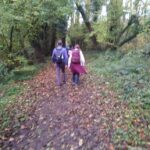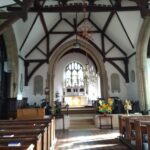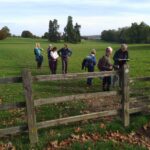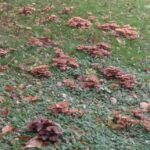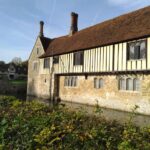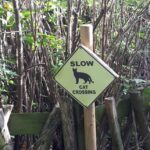Poly Ramblers put the last day of summer-time to good use! We were very lucky with the trains and the weather! It wasn’t far after leaving Borough Green station before we were strolling purposefully along a woodland path, enjoying the beneficial boost to our immune systems and normalising our cortisol levels amongst the trees. Soon after that we walked through an orchard where some of us stooped to pick up windfalls – some very large apples that were still perfectly edible. When we did the walkover in mid-September there were of course more medium sized apples which had fallen on the ground but they had since been scooped up by other passers-by no doubt, or invaded by insects or slugs!
We pressed on across a stream, up an enclosed path and then gently downhill to Plaxtol Church. On our previous visit one of the local ladies polishing the brass in the church pointed out that it didn’t have the name of a saint because it was “Cromwellian”, built in 1649. The Saturday Walkers’ Club Guide mentions that Thomas Stanley of Hamptons contributed to the repair of the church. A member of our group was intrigued to hear that this gentleman was subsequently beheaded for his part in the execution of Charles I. However our companion’s later extensive research showed no sign of affiliation to Cromwell’s cause, rather that Thomas Stanley was a Royalist. Imagine the turmoil and conflicting allegiances amongst the landowners and villagers in those days in such a relatively small area! There is a 345 page PhD thesis on such a subject where Thomas Stanley is mentioned, if you are interested! Putting on our boot covers, we took advantage of the parish hospitality, sampling the tea, coffee and biscuits and other facilities available, leaving donations to show our appreciation as we went on our way. Soon after, we climbed over a stile in a stone wall and, admiring the views of the distant misty hills, crossed the parkland of the Fairlawne Estate where, according to the 1998 edition of the Time Out Book of Country Walks, the Queen Mother’s horses were trained. At the time that book was written Fairlawne was Arab-owned. We could see the impressive Fairlawne House over to our right but there was no evidence of race horses or their trainers, only of sheep.
We carried on across fields and down paths between high hedges to our lunch stop at Ightham Mote, eating our picnic in the sunshine at the tables provided by the National Trust, but sadly we never have enough time to visit the manor house. “One of these days” we say as we leave! We were at least able to get a good view of the outside of the house as we went on our way. Intriguing design! All those chimneys! They’d need a lot of firewood! Perhaps long ago there were even more woods in the vecinity! Along the lane and onto another woodland path, passing the Hoppers’ Huts, where people who came down from London to pick hops in the 19th and early 20th centuries stayed, in apparently very basic not to say insanitary conditions. The path gradually climbed through the woods, eventually emerging in an wide open area with lavender fields on either side which would be worth revisiting in the season. When we came to a road and crossed into a sloping field, I was reminded of the first time I followed this part of the route (1999 or so) when the whole hillside was covered in a fan-shape of apple orchards which were all grubbed up not long after, due to the competition from French Golden Delicious, I thought at the time! Now there is only a slim avenue of young apple trees, which in September were still laden with ripe red dessert apples (and the ground covered in windfalls) but at the end of October the trees were bare of fruit and the windfalls were insect hotels! The group strode on up the hill and along the side of a wood where we passed two young ladies collecting up fallen sweet chestnuts. Must remember my heavy-duty gardening gloves next autumn! We did pass secluded oast houses and cottages but on the whole we only saw the occasional dog walkers, sometimes more than once! In and out of woods and across lanes, we emerged on a road which took us to the grounds of Sevenoaks Prep School. No 4x4s picking up pupils as there were on our walkovers, we crossed between empty football pitches to the other side of the sports field, into a lane and up to the wire-netting deer-protection entrance gate to Knole Park. Springy grassland, bracken, old oak trees, deer glancing up at us and resuming grazing. Down a steep slope and up the other side, crossing the golf course with care, on the designated path, towards Knole House (well worth a visit, another time!). The sight of the long tearoom queue persuaded us to continue the undulating route to the other side of the park, in plenty of time for some of us to partake of tea and cake in the Malabar Coffee House on Sevenoaks High St and others to carry on to the station. A perfect way to round off a very enjoyable day out and say goodbye to summer on a high note!
Pam


